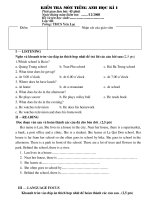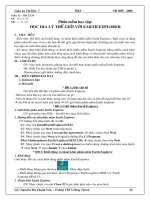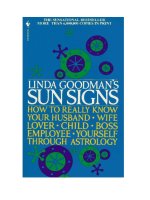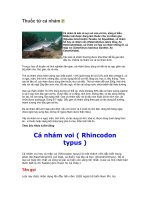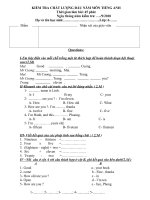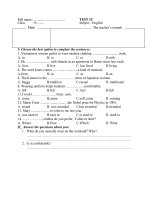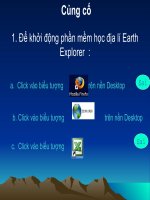- Trang chủ >>
- THPT Quốc Gia >>
- Hóa
Sun earth moon
Bạn đang xem bản rút gọn của tài liệu. Xem và tải ngay bản đầy đủ của tài liệu tại đây (2.94 MB, 10 trang )
Genre
Nonfiction
Comprehension Skill
Main Idea and
Details
Text Features
•
•
•
•
Captions
Charts
Diagrams
Glossary
Science Content
Earth and Space
Scott Foresman Science 6.19
ISBN 0-328-14025-2
ì<(sk$m)=beacfb< +^-Ä-U-Ä-U
Vocabulary
What did you learn?
lunar eclipse
orbit
revolve
rotate
solar eclipse
1. Describe the surface of the Moon and what it
is made of.
2. What causes the seasons on Earth?
3. What were the Apollo missions?
4.
Write to explain the positions
of the Sun, the Moon, and Earth during solar and
lunar eclipses.
5.
Predict Use what you know about velocity to
predict the motion of a volleyball during a
volleyball game.
by Mary F. Blehl
Picture Credits
Every effort has been made to secure permission and provide appropriate credit for photographic material.
The publisher deeply regrets any omission and pledges to correct errors called to its attention in subsequent editions.
Photo locators denoted as follows: Top (T), Center (C), Bottom (B), Left (L), Right (R), Background (Bkgd).
Opener: Brand X Pictures; 1 Brand X Pictures; 2 (T, B) Brand X Pictures; 4 (B) Brand X Pictures, (CR) Getty Images;
5 (CL) Brand X Pictures; 6 (B) Brand X Pictures, (T) Getty Images; 7 (TR, CR) NASA; 8 (TL, B) Brand X Pictures; 9 (BC)
Brand X Pictures; 10 (CR, B) Brand X Pictures; 12 (B) Brand X Pictures; 13 (TL) David Nunuk /Photo Researchers, Inc.,
(CR) Brand X Pictures, (BC) Dr. Fred Espenak /Photo Researchers, Inc.; 14 (B) Brand X Pictures, (T) Fred Espenak/
Photo Researchers, Inc.; 15 (CR) John Chumack /Photo Researchers, Inc.; 16 Brand X Pictures.
Unless otherwise acknowledged, all photographs are the copyright © of Dorling Kindersley, a division of Pearson.
ISBN: 0-328-14025-2
Copyright © Pearson Education, Inc. All Rights Reserved. Printed in the United States of America.
This publication is protected by Copyright, and permission should be obtained from the publisher prior to any
prohibited reproduction, storage in a retrieval system, or transmission in any form by any means, electronic,
mechanical, photocopying, recording, or likewise. For information regarding permission(s), write to
Permissions Department, Scott Foresman, 1900 East Lake Avenue, Glenview, Illinois 60025.
3 4 5 6 7 8 9 10 V010 13 12 11 10 09 08 07 06 05
Reactions in the Sun’s core release massive amounts of energy.
Energy released in the core travels through layers of plasma inside
the Sun until it reaches the surface. Some of this energy comes to
Earth as light and infrared radiation. Light from the Sun illuminates
our days and provides energy for green plants. Infrared radiation
provides heat. Without the Sun’s heat, Earth would become colder
than the North Pole.
The Sun’s outer layer, called the corona, is about 8,000,000 miles
thick. Solar flares, which are powerful explosions of gases, occur on
the Sun’s surface. These flares create intense radiation. If some of
that radiation reaches Earth, it sometimes causes a magnetic storm.
This disrupts radio communications on Earth. Other times the
radiation causes auroras, which are colorful lights in the sky.
Four hundred years ago,
Galileo became the first person
to discover the dark spots on the Sun
that we now call sunspots.
sunspot
Features Of
The Sun and Moon
The Sun
The Sun is the nearest star to Earth. It is so huge that a
million Earths could fit inside it! The Sun looks like a giant
ball of fire in the sky. At one time, people thought it was a
huge burning rock, similar to a piece of coal on fire. Actually,
the Sun is neither burning nor solid. It is made of a type of super
hot matter called plasma, which is similar to a gas. The plasma’s
heat causes it to glow very brightly. Reactions between particles
in the Sun’s core cause its intense heat. Temperatures in the core
may reach 15,000,000ºC.
2
This aurora is caused
by solar radiation
interacting with Earth’s
upper atmosphere.
3
The Moon orbits Earth.
Both Earth and the Moon
rotate on an axis.
Waning and Waxing
Just like Earth, one half of the Moon is always lighted by
the Sun, while the other side is not. When none of the lighted
part is visible from Earth, we call it a new moon. As the Moon
keeps moving in its orbit, we see more of the part that is reflecting
sunlight. This is called waxing, which means “growing larger.” The
Moon waxes until we see its entire lighted half, called a full moon.
As the Moon continues in its orbit, the phases reverse. It appears
to be getting smaller, or waning, until it becomes a new moon
again. It takes about 29.5 days for the cycle of Moon phases to be
completed.
Earth’s Satellite
The Moon is the closest body in space to our Earth. It is
more than four billion years old! The Moon has no light of
its own. Light from the Sun reflects off it, and that is the only
way we can see it from Earth.
The Moon is Earth’s satellite. That means it revolves in
an orbit around Earth. An orbit is the path that a body in
space follows around another object.
It takes 27.3 days for the Moon to rotate, or spin, on its axis.
It takes exactly the same amount of time for the Moon to revolve,
or complete its orbit around Earth. Because of this, the same side
of the Moon faces Earth at all times.
Phases of the Moon
As the Moon revolves around Earth, it seems to have
different shapes. But the shape of the Moon does not actually
change. What changes is the part of the Moon’s lighted surface
that is visible from Earth. The Sun always lights half of the
Moon, but at different places in the Moon’s orbit different
amounts of the lighted area are visible from Earth. We call
the different visible parts “phases.”
4
Here you can see the phases of the Moon
as it revolves around Earth.
last quarter
the
Sun
new moon
full moon
Earth
first quarter
5
crater
The darker parts
are the “seas.”
In 1959 the first spacecraft
landed on the Moon. This Soviet
vehicle, named Luna 2, did not have
any humans on board. In 1969 Neil
Armstrong was the first person
to step on the Moon. As he did it
he said, “That’s one small step for
man, one giant leap for mankind.”
Armstrong and Edwin “Buzz” Aldrin
brought back the first samples from
the Moon’s surface. Michael Collins,
the mission’s pilot, remained in the
spacecraft, orbiting the Moon.
From 1969 to 1972 there were six
Apollo missions altogether. Twelve
astronauts took pictures there and
brought back rock and soil samples.
During the last mission, the men
stayed on the Moon for three days.
The lunar rover let astronauts
explore large areas of the Moon.
On July 20, 1969, the first
humans walked on the Moon.
The lunar lander separated from
a larger spacecraft and landed on
the Moon’s surface.
Studying the Moon
The surface of the Moon is mostly dust and rock. There is
almost no atmosphere on the Moon. Without atmosphere to
protect it from the Sun’s radiation, it can get very hot in sunlit
areas. Also, without much atmosphere, very little heat is absorbed,
so dark areas of the Moon are extremely cold.
On the Moon’s surface, we can see dark gray plains. Early
astronomers named these areas mare. Mare is a Latin word for sea.
Early astronomers thought these areas were seas. We now know
they are flat plains of cooled lava, but the name stayed. There are
highlands around the craters and the seas. Craters are indentations
of different sizes left by meteorites that hit the Moon.
6
7
Earth’s rotation on its axis
causes night and day.
It is daytime on
this side of Earth.
Only one half of Earth is lit by the
Sun at a particular time. The other
half is in darkness. That is why
when it is daytime in the United
States, it is nighttime in China.
It is nighttime on
this side of Earth.
The Moon and Earth
In Motion
In most places on Earth, there are more hours of daylight
during the summer than there are during the winter. This is
caused by Earth’s tilted axis. Look at the diagram on page 8.
Notice that the southern part of the planet is tilted toward the
Sun, while the northern part is tilted away. The parts of Earth
that are tilted toward the Sun have more daylight hours. The parts
that are tilted away have fewer.
This effect is greatest at the poles. When the North Pole is
tilted toward the Sun, it gets sunlight twenty-four hours a day.
The Sun is up all day for six months! When the North Pole is
tilted away from the Sun, it is dark all the time.
Have you ever seen the Moon during the day? Although we
usually see the Moon only at night, it is often on your side of
Earth during daytime.
Earth’s Rotation
As ancient people watched the sky from Earth, it looked as
though the Sun was moving around our planet. The Sun seemed
to rise in the morning, travel across the sky, and set in the evening.
Eventually, people learned that Earth orbits the Sun, not the
other way around!
Earth revolves around the Sun in an orbit, and it also rotates
on its axis. It rotates every twenty-four hours. This rotation is
what causes us to have night and day.
Earth always rotates in the same direction. This is why the
Sun appears to rise in the east and set in the west. Earth rotates
from west to east. We see the Sun first in the east because Earth
is turning toward that direction.
8
The Sun is not exactly
in the middle of
Earth’s orbit.
Earth’s orbit has the
shape of an ellipse.
9
The direction of Earth’s tilt
on its axis causes the seasons.
March
In spring, as in fall, neither pole tilts toward the Sun,
and both hemispheres have mild temperatures.
When the North Pole
tilts toward the Sun,
the Northern Hemisphere
of Earth has summer,
and the Southern
Hemisphere has winter.
December
June
When the South Pole
tilts toward the Sun, the
Southern Hemisphere of
Earth has summer, and the
Northern Hemisphere has
winter.
In fall, neither pole tilts toward the Sun,
so both the Northern and the Southern
Hemispheres of Earth have mild temperatures.
September
Seasons Change
Days, years, and seasons are caused by Earth’s motion.
Days and nights are caused by Earth’s rotation on its axis. A day,
about 24 hours, is the total time Earth takes to make one full
rotation. A year, about 365 days, is the amount of time it takes
Earth to complete one revolution around the Sun.
Earth revolves around the Sun following an elliptical path.
Because Earth’s path is an ellipse, it is sometimes slightly closer
to the Sun than at other times. People think that summer occurs
when Earth is closer to the Sun. But this has nothing to do with
the seasons.
10
The seasons are caused by the tilt of Earth’s axis. The Sun
warms the part of Earth that is tilted toward it more than it does
the side that is tilted away. The part that is tilted toward the Sun
has summer, while the other part has winter. The tilt causes the
temperature to change by changing the angle at which the Sun’s
rays hit Earth. When part of the planet is tilted toward the Sun,
that part receives sunlight at a direct angle, delivering lots of heat.
When part of Earth is tilted away from the Sun, the angle is less
direct. The Sun’s rays are more spread out, so they do not warm
that part as much.
11
In an annular eclipse,
a small part of the Sun
can be seen around
the edge of the Moon.
Solar Eclipses
The changing positions of the Sun, the Moon, and Earth can
cause solar and lunar eclipses. A solar eclipse is when the Moon
passes directly between the Sun and Earth. Although the two
bodies are not the same size, sometimes the Moon will block the
Sun’s light for a while. The Moon crosses a little above or below
the Sun because of the tilt of its orbit. But sometimes the orbit
of the Moon crosses exactly between the Sun and Earth. When
the three bodies are in line, the Moon casts a shadow on Earth,
blocking the Sun. The shadow has a small, dark center called the
umbra, and a lighter outer part called the penumbra. When the
Moon seems to block all the sunlight, we call it a total eclipse.
Total eclipses are seen only in areas covered by the umbra. If the
Moon blocks only part of the sunlight, we call it a partial eclipse.
Partial eclipses can be seen in areas covered by the penumbra.
When the Moon gets into position for an eclipse, sometimes
we see only the Sun’s corona. It looks like a bright glow around
the Moon. At other times, the Sun is closer than usual, and
the Moon is farther away than usual. Then the whole Sun does
not seem to be covered by the Moon. This is called an annular
eclipse. You can see the Sun in the shape of a ring!
Here you can see the placement of the Sun,
Moon, and Earth during a solar eclipse.
Here you can see the corona of
the Sun during a solar eclipse.
These photographs show the different
stages of an annular solar eclipse.
A partial eclipse is seen in areas
covered by the penumbra.
Solar Eclipses
the Sun
the Moon
A total eclipse is seen in
areas covered by the umbra.
12
Earth
Date
Where the eclipse can be seen
March 29, 2006
Atlantic Ocean, northern Africa, central Asia
August 1, 2008
Arctic Ocean, Greenland, Russia, China
July 22, 2009
Arctic Ocean, Greenland, Russia, China
13
The photographs above
show the different stages
of a total lunar eclipse.
Lunar Eclipses
At certain times of the year, the Sun, Earth, and Moon can
line up to cast a shadow on the Moon. Up to three times a year,
the full Moon moves through Earth’s shadow. When Earth blocks
the sunlight from reaching the Moon, we call this a lunar eclipse.
Lunar means “related to the Moon.” Lunar eclipses can be partial,
total, or penumbral.
During a partial lunar eclipse, Earth’s shadow covers only part
of the Moon. During a total lunar eclipse, the shadow covers the
entire Moon. During a penumbral lunar eclipse, the Moon moves
through the outer edge of Earth’s shadow and its light is only
slightly dimmed.
A lunar eclipse can be seen from any part of Earth that can
see the Moon at that time. Scientists know when lunar eclipses
will occur. In the chart on the opposite page, you can see when
the next one will happen.
This is the placement of the Sun, the Moon,
and Earth during a total lunar eclipse.
the Sun
Earth
The eclipse is visible from
anywhere on the dark side of Earth.
14
The Moon is in
Earth’s shadow.
the Moon
During a lunar eclipse,
the Moon can look reddish.
Lunar Eclipses
Date
Type of eclipse
October 17, 2005
partial
September 7, 2006
partial
March 3–4, 2007
total
August 28, 2007
total
February 21, 2008
total
15
Glossary
Vocabulary
lunar eclipse
orbit
revolve
lunar eclipse an eclipse that occurs when Earth casts
rotate
a shadow on the Moon
solar eclipse
orbit
a path that a body follows in space, usually
around another body; for example, Earth
moving around the Sun
revolve
to move around an object in space in an orbit;
for example, when Earth moves around the Sun
rotate
to move around an axis; for example,
when a top spins, or Earth spins in space
solar eclipse
an eclipse that occurs when the Moon
passes between the Sun and Earth,
blocking the Sun’s light
Picture Credits
Every effort has been made to secure permission and provide appropriate credit for photographic material.
The publisher deeply regrets any omission and pledges to correct errors called to its attention in subsequent editions.
Photo locators denoted as follows: Top (T), Center (C), Bottom (B), Left (L), Right (R), Background (Bkgd).
Opener: Brand X Pictures; 1 Brand X Pictures; 2 (T, B) Brand X Pictures; 4 (B) Brand X Pictures, (CR) Getty Images;
5 (CL) Brand X Pictures; 6 (B) Brand X Pictures, (T) Getty Images; 7 (TR, CR) NASA; 8 (TL, B) Brand X Pictures; 9 (BC)
Brand X Pictures; 10 (CR, B) Brand X Pictures; 12 (B) Brand X Pictures; 13 (TL) David Nunuk /Photo Researchers, Inc.,
(CR) Brand X Pictures, (BC) Dr. Fred Espenak /Photo Researchers, Inc.; 14 (B) Brand X Pictures, (T) Fred Espenak/
Photo Researchers, Inc.; 15 (CR) John Chumack /Photo Researchers, Inc.; 16 Brand X Pictures.
Unless otherwise acknowledged, all photographs are the copyright © of Dorling Kindersley, a division of Pearson.
ISBN: 0-328-14025-2
Copyright © Pearson Education, Inc. All Rights Reserved. Printed in the United States of America.
This publication is protected by Copyright, and permission should be obtained from the publisher prior to any
prohibited reproduction, storage in a retrieval system, or transmission in any form by any means, electronic,
mechanical, photocopying, recording, or likewise. For information regarding permission(s), write to
Permissions Department, Scott Foresman, 1900 East Lake Avenue, Glenview, Illinois 60025.
3 4 5 6 7 8 9 10 V010 13 12 11 10 09 08 07 06 05
16
What did you learn?
1. Describe the surface of the Moon and what it
is made of.
2. What causes the seasons on Earth?
3. What were the Apollo missions?
4.
Write to explain the positions
of the Sun, the Moon, and Earth during solar and
lunar eclipses.
5.
Predict Use what you know about velocity to
predict the motion of a volleyball during a
volleyball game.
